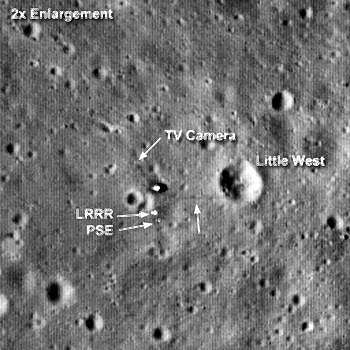Armstrong's Footprints on Lunar Surface
 Just over 40 years after Armstrong and Aldrin made the first footprints on the surface of the moon, the NASA Lunar Reconnaissance Orbiting Camera (LROC) took the first of several images from lunar orbit showing the astronaut's tracks from its vantage point high above the moon.
Just over 40 years after Armstrong and Aldrin made the first footprints on the surface of the moon, the NASA Lunar Reconnaissance Orbiting Camera (LROC) took the first of several images from lunar orbit showing the astronaut's tracks from its vantage point high above the moon.
 |
| The highest resolution image taken on a later orbit of the Lunar Reconnaissance Orbital Camera (LROC) The tracks made by Neil Armstrong are seen leading to the 33-foot-wide "Little West" crater, the first crater ever imaged directly by an astronaut. Notice that even the lunchbox-sized television camera is also identified! |
As amateur astronomers, virtually everyone in a two-state area who has ever visited one of our AOAS star parties has wondered about the American "flag" planted on the surface of the moon by Neil Armstrong and "Buzz" Aldrin. Why I had not considered this before did not strike me until after the first of the very latest LROC images had been released for public inspection...why the flag, and not the footprints? After all, the footprints are the living proof that men had actually gone to the moon. They landed in a relatively tiny two-stage lander and then exited the craft to place human footsteps on the moon. To me, at least, this is the defining statement of the entire Apollo era. But what most people wanted to know was, "Where can we see the flag?
I assume it goes with the whole concept of the so-called Space Race. The "race" was merely a rush to build the most effective, accurate, and most rapid delivery system for our nuclear arsenals, both from the U.S. and the U.S.S.R. The ability to place a human on the surface of the Earth's satellite had NOTHING whatsoever to do with science, although the science that American astronauts provided to the professional scientific community had a profound impact on planetary science as well as to other fields of knowledge. With the first American astronauts to travel from Earth to orbit the moon nearly 7 months prior to the manned landing in December 1968, Apollo 8 only barely beat the first Russian moon launch when their gigantic rocket called NOVA blew up in the first full-up launch of the U.S.S.R rocket system according to CIA documents made public decades after the event. The damage done to their launch facilities in the Russian plains was so extensive that for all intents and purposes, their entire "race" was over in one disastrous fell swoop.
While Apollo 8 only orbitted the moon a total of ten times, it solidified for the first time that men from the United States had actually travelled to another world in our solar system. Before this, U.S. rockets had delivered several craft to the moon on various missions from just imaging the moon as the Ranger probes snapped pictures until they raced into full-blown calamity impacting on the surface, to the later Ranger craft which actually soft-landed in the Sea of Storms roughly 1-and-a-half years prior to the landing of Apollo 12 which touched down only a few hundred yards away from the Ranger craft. One of their Apollo 12 mission objectives was to retreive the television camera which had filmed the robotic arm reaching over into the lunar soil and scooping up a small amount of soil for sampling. That TV footage was nearly as historic as the first manned landing, and provided several important reasons for being returned to Earth by astronauts Bean and Conrad a few months after the Apollo 11 mission had completed successfully. But it was the footprints that were the biggest news from this summer's high resolution pictures returned by the Lunar Reconnaissance Orbiting Cameras.
 |
| Astronaut Pete Conrad at the Ranger landing site about to remove the television camera to return it to NASA scientists. |




















